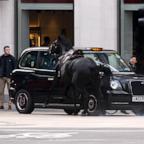Take a Deep Breath: Going Down With the Extremely Extreme Sport of Deep-Breath Diving
ABC's Jeffrey Kofman travels to Greece to experience this tough sport first hand
KALAMATA, Greece May 26, 2012— -- William Winram makes it sound so easy.
"You're going to hold your breath, pull yourself down a line under the sea," says the champion deep diver from Canada. Then he laughs. I am having my doubts about this assignment.
Winram and I are sitting on a floating diving platform half a mile off the coast of Kalamata, Greece. This is the site of the annual World Free Diving Championships. I have come see what it is all about. What I am quickly learning is that this is one of the most extreme of extreme sports. Divers descend to unthinkable depths in the ocean -- more than 700 feet down -- with no air tanks. That's why it is also called Breath-Hold Diving.
We are wearing wet suits and fins and adjusting our face masks.
"The urge to breath is actually not because oxygen levels are low, it's because CO2 levels are high and it's just a natural protective reflex. But the more you dive, the more you train yourself, the better you get at breathing, the better your body adapts to holding your breath," says Winram as he tries to reassure me. "You'll be surprised, even for rank beginners it's not difficult to teach them in a short period of time how to hold their breath for two or three minutes."
Divers spend years learning how to do this. In one day I have no intention of going down deep, but Winram insists that even a shallow breath-hold dive will give me – and viewers – a sense of what it takes. I gulp a deep breath. Winram corrects me. It's not about filling your chest, it's about filling your lungs. He sips air like he's slurping a bowl of hot soup, slowly filling his lungs to capacity as his belly expands.
"So you're breathing through the snorkel," he tells me, "holding the breath, taking the snorkel out, pinch, gently blow and start the dive."
"Do I let the air out bit by bit while I am underwater?" I ask.
"No," he says, revealing the secret of breath-hold diving, "you let the air out when you are back on the surface."
We jump in the water and swim to a cable suspended from the diving platform. Winram attaches his safety cord to the cable, slowly sips in air and descends to the deep. He moves in slow motion. Flipping his funs and using his arms he goes down effortlessly, like a classical dancer floating across the stage. When he surfaces he lets out his breath slowly. He's not even gasping.
Winram explains that the average person breathes 15 to 20 times a minute. He has taught himself take deeper, longer breaths. "If I'm sitting watching TV or at the computer, it's maybe two or three breaths a minute." He says it comes from years of training, "Chinese martial arts and meditation and yoga and the diving have changed my breathing."
(Winram and diving partner Fred Buyle no longer compete. They use their unique underwater skills to swim with sea creatures, including sharks. They say that without the noise of air tanks they are able to get much closer to the animals without startling them. It is, however, a double feat of daring: they are swimming underwater without tanks and without cages to protect themselves from the sharks. So far, they've survived without incident, the proof is can be seen in some spectacular photographs they have taken.)




